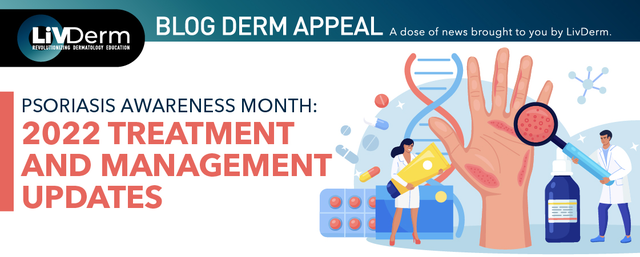August is Psoriasis Awareness Month and a perfect opportunity to highlight this disease and attempt to understand and appreciate the many facets that accompany a psoriasis diagnosis for both patients and health care providers.
As a chronic autoimmune disease, psoriasis affects over 3% of the adult population in the U.S. and is the most prevalent autoimmune disease in the country. Furthermore, one in three people with psoriasis may also develop psoriatic arthritis, which can severely impact on quality of life. In fact, one study shows that approximately 60% of people suffering from psoriasis reported their disease to be a large problem in their everyday life, with 40% of those with psoriatic arthritis saying the same.
With various research evidencing a direct correlation between psoriasis and other health conditions such as cardiovascular disease, diabetes, obesity, depression and anxiety, identifying the right treatment plan for patients with psoriasis can prove challenging for health professionals. And though there is no cure available, current options include topical treatments, phototherapy and systemic treatments, with many individuals also opting for what is referred to as complementary therapies which include acupuncture and supplements.
Challenges to Treatment
As with many other conditions, treatment plans differ from patient to patient depending on the type of psoriasis, its location, severity and the possible existence of other health conditions. Health care providers are aware of the need to find the right balance of treatment.
What is more, experts also identify a number of other challenges to the treatment and management of psoriasis in their patients as different variables exist for both the patient and the disease.
While there are a number of treatment options available, as with many things, each have their advantages as well as their own drawbacks. With topical creams for instance, patients are required to apply these regularly, yet many have issues relating to the psoriasis presenting itself in hard to reach areas or having to cope with certain side effects such as the thinning or discoloration of the skin with steroid-containing topicals. This is one of the reasons that tapinarof (Vtama) 1% cream was seen as a huge breakthrough as it is a non-steroidal option, thus removing the complications that accompany steroidal creams. This, along with ZORYVE (roflumilast) cream 0.3%, recently approved by the U.S. Food and Drug Administration, are considered safe and well-tolerated.
Safety and Adherence
While systemic options may seem like an easier route, researchers and providers have also identified that these can also present other complications and side effects such as injection site reactions, an increased rate of infection, with some patients also developing antibodies which make them less effective. Furthermore, the use of biologics as a treatment method is not always welcomed by patients as many are worried about the safety aspect of it.
As a result of the complications that arise from some of these treatment options, many patients may start out on a regimen and later do not follow through or complete it, making it difficult for their health care providers to gauge the effectiveness or appropriateness of a particular treatment method.
Comorbidities
For many patients, Psoriasis symptoms can fluctuate due to a variety of triggers and factors that include stress, skin injury and the weather. This makes finding the most effective, balanced treatment option difficult.
Other patients present with pre-existing or new health conditions that may or may not be directly related to their psoriasis diagnosis. In these instances, not only does treatment become more difficult but in many cases, patients are also more likely to be wary of their options. This in turn leads to added social and psychological stressors on the patient as well as their health care providers.
It is not surprising therefore that many of those who suffer from psoriasis are additionally prone to depression and anxiety as they attempt to deal with the stigmas associated with the disease. Many still feel ostracized and have difficulty coming forward to talk about the condition, or finding someone who they are comfortable to confide in.
Staying Up-to-Date
With all the challenges that exist, staying abreast of new and emerging treatments and therapies is an essential aspect of the overall management of psoriasis and care of patients. In fact, along with the recent approval of roflumilast, the FDA has also approved the label expansion of STELARA® (ustekinumab) to treat pediatric patients with active psoriatic arthritis.
In addition, take advantage of LiVDerm’s dedicated Psoriasis Digital Education Hub that is regularly added to and includes live sessions and podcasts from our renowned expert faculty.
Key Takeaway
Keeping track of the latest developments in psoriasis is essential, and so too is the need for dermatologists to not just recognize the many physical and medical challenges that come with a psoriasis diagnosis, but also to understand and identify the psychological aspects. It is important to provide collaborative care with other specialists such as psychiatrists, rheumatologists as well as primary care physicians, in order to provide the most suitable treatment plan for their patients.
Sources:
- https://www.managedhealthcareexecutive.com/view/top-6-challenges-managing-psoriasis
- https://www.healthline.com/health/psoriasis#symptoms-of-psoriasis
- https://www.psoriasis.org/
- https://mg217.com/your-psoriasis/statistics-about-psoriasis/
- https://www.hcplive.com/view/the-challenges-of-plaque-psoriasis-management
















